
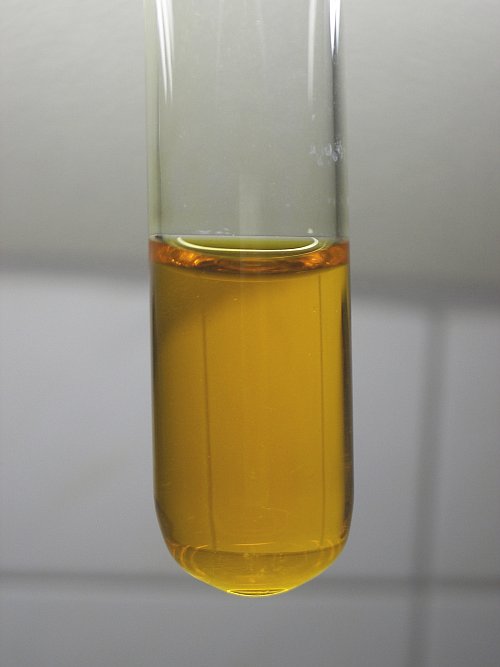

Aqueous solutions and precipitates of chromium
In aqueous solutions, chromium can exist in the +2, +3, +5, and +6 oxidation states. In the solid state, chromium also can exist in the +4 oxidation state. The +2 oxidation state is very strongly reducing and that can only exist for a short time, it is very quickly oxidized to the +3 oxidation state. Oxidation state +3 is the most stable, both in acidic and in alkaline solutions. Oxidation state +5 is a rare oxidation state for chromium. This is only stable, with peroxo-ligands and in alkaline environments. Finally, oxidation state +6 also is quite stable, as long as no reducing agents are present. Most remarkable is that this oxidation state also exists in the gaseous state.
All 5 oxidation states are covered on this page. Solutions of the different species are shown and where appropriate, precipitates are shown.
![]()
Oxidation state +2
This oxidation state of chromium is so strongly reducing, that it is really hard to obtain a solution of this and keep this around for a reasonable time. A precipitate of chromium (II) hydroxide is even harder to maintain. As soon as hydroxide is added to a solution of a chromium (II) salt, then hydrogen gas is produced and the grey/green precipitate of chromium (III) hydroxide is formed.
Below, four pictures are shown. The top-left picture shows the color of aqueous chromium (II) ions, made by dissolving some chromium metal in fairly concentrated hydrochloric acid, while assuring that no fresh air can reach the reaction mixture.
The top-right picture shows what happens if some of the blue liquid, containing chromium (II) ions, is added to some excess amount of a solution of sodium hydroxide. One can clearly see the bubbles of hydrogen, formed at the precipitate. Where the hydrogen bubbles are formed, the precipitate turns grayish green, at other places, it looks more bright green, but it is not sure whether this is the real color of chromium (II) hydroxide. The green color may also be due to the fact, that the precipitate is watched through some green/blue liquid.
The bottom left picture shows the precipitate, immediately after a little shaking. One can clearly see, that the color already has become much more grayish green.
The fourth picture shows the precipitate after a longer time of shaking. All chromium (II) has been oxidized to chromium (III) and the precipitate just looks like a precipitate of chromium (III) hydroxide, as shown further below in the section for oxidation state +3.
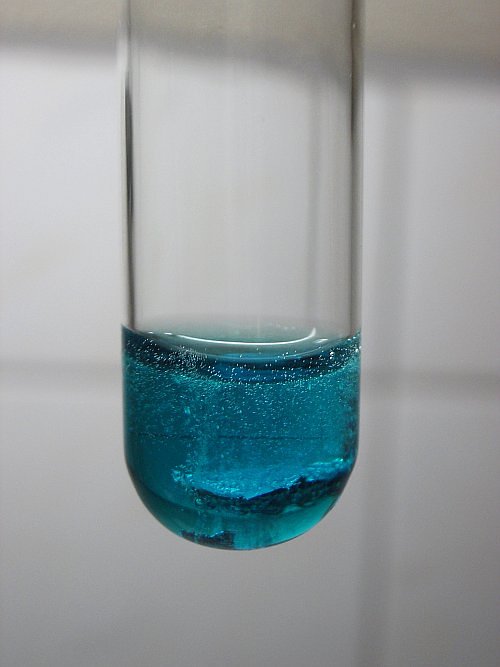
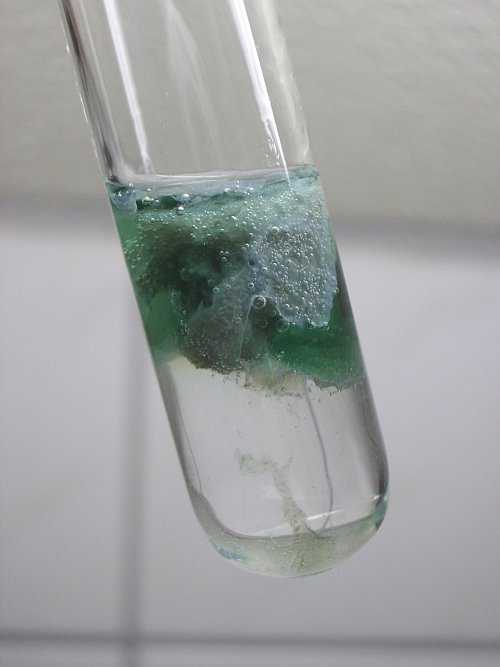
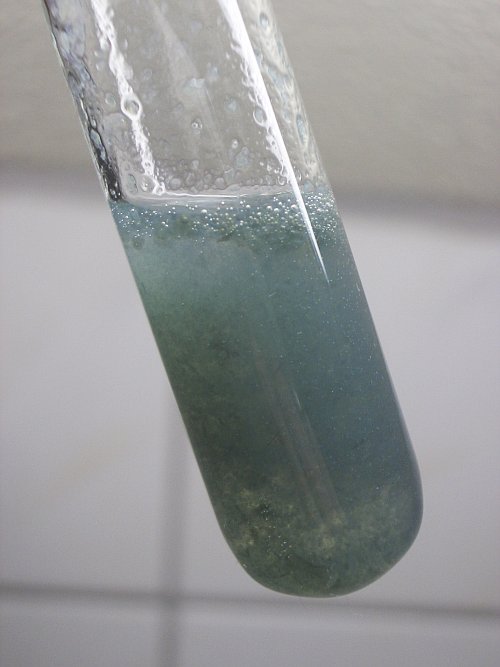
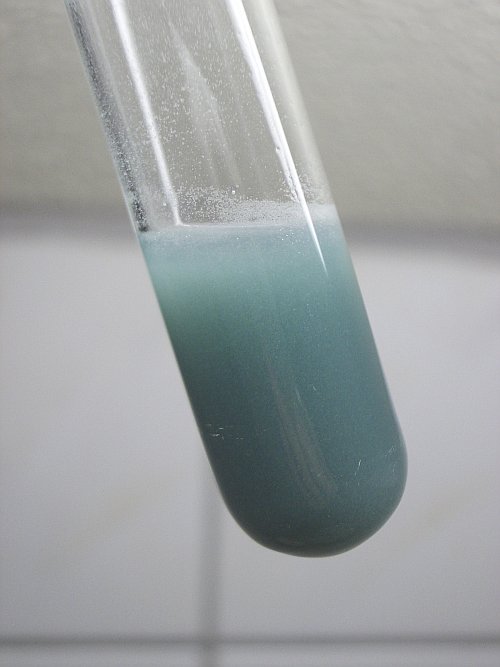
![]()
Oxidation state +3
As stated already, this is the most stable oxidation state. In acidic and neutral solutions, the species Cr3+(aq) is present in solution. The color of this ion is very hard to describe and strongly depends on the light, used for viewing the solution. Under normal daylight conditions, the color is somewhat bluish/green/gray. When hydroxide is added, then a gray/green precipitate, with a bluish hue is formed. When an excess amount of hydroxide is added, then a deep green solution is formed.
The color of the chromium ions in its +3 oxidation state are fairly strong, so even a moderately concentrated solution already looks dark. Below, two series of pictures are given. The upper series shows a somewhat more concentrated solution (a small spatula of solid, dissolved in approximately 4 ml of water). The lower series shows a very dilute solution, with just a pinch of solid chromium salt.
Both series show the neutral solution of potassium chrome alum at the left, which gives plain aqueous Cr3+(aq) in solution. The middle pictures shows the precipitate of chromium (III) hydroxide. The right pictures show that the precipitate dissolves again, forming green chromate (III), which can approximately be written as CrO(OH)43-(aq). Other formulations for the green ion sometimes are CrO2–(aq) and CrO33-(aq).

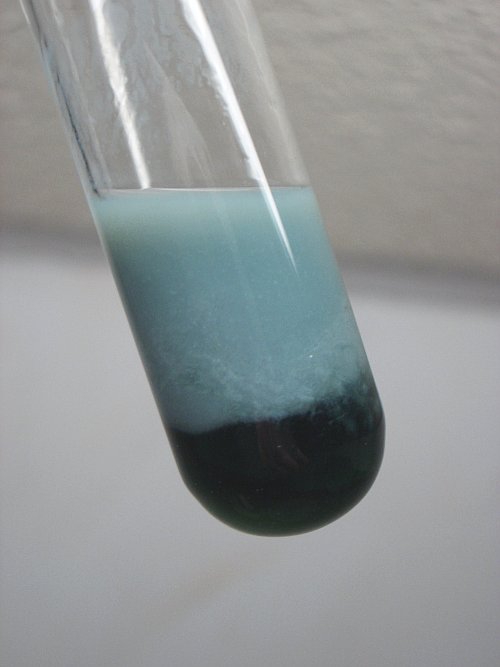
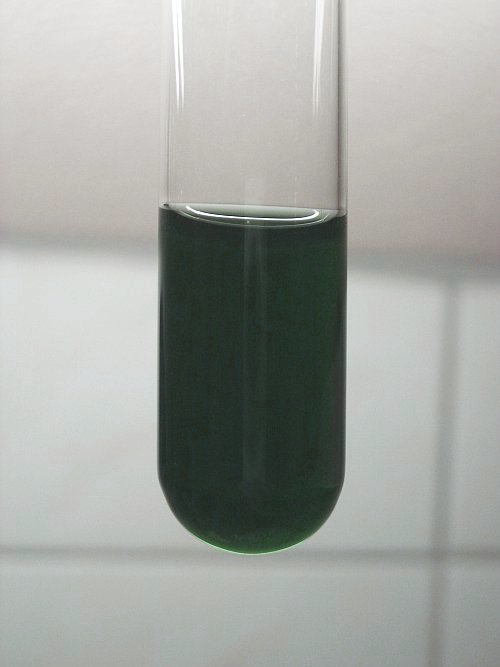
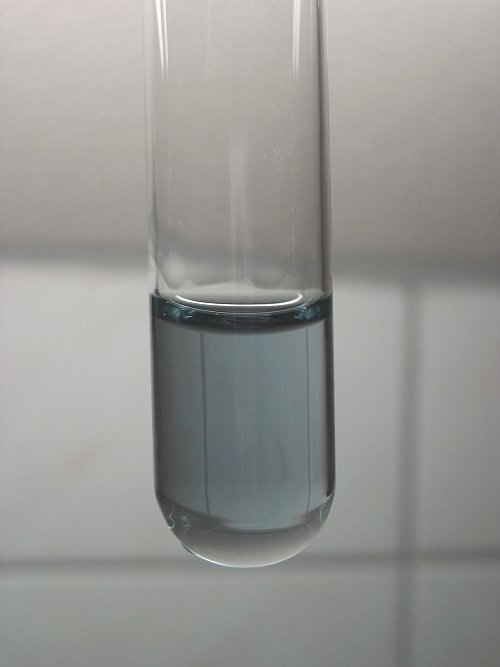
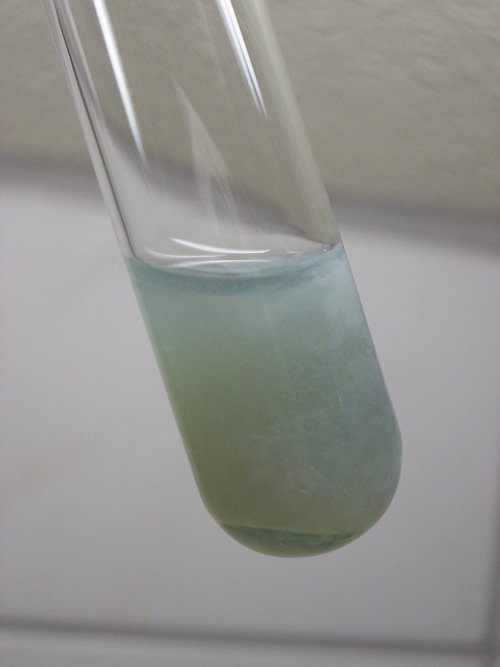
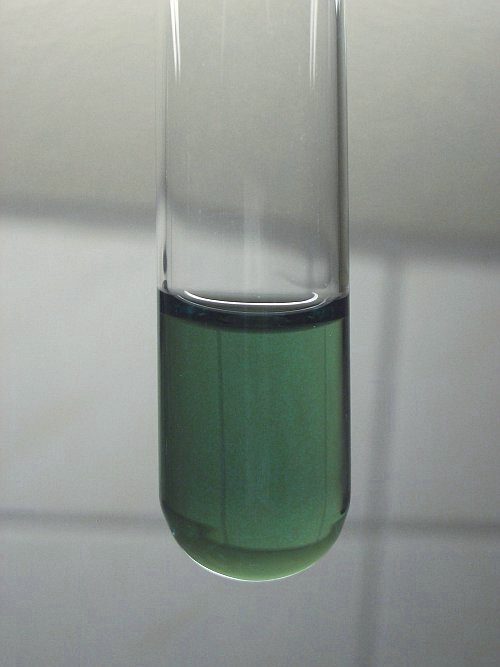
Chromium in its +3 oxidation state can exist in many complexes, which can have a lot of different colors. Chromium (III), together with cobalt (III) are the metals which have the most extensive aqueous coordination chemistry of all metals. It is impossible to show all different colors in which chromium (III) can exist in its coordination complexes. Some colors are violet, green, brown and even grey.
![]()
Oxidation state +4
From aqueous solution, one can easily prepare a chromium (IV) compound. If one adds a solution of potassium dichromate to a solution of chrome alum, then the dichromate ion slowly oxidizes the aqueous chromium (III) ions. The resulting compound is the dioxide, CrO2, which settles as a brown precipitate at the bottom of the test tube. The reaction is quite slow and takes several days. Below, a sample of chromium (IV) oxide, prepared in this way, and rinsed a few times with water in order to remove most of the dichromate, is shown here. The yellow color above the precipitate is due to remnants of dichromate. The picture nicely shows the brown precipitate. One also can easily see that originally, the level of the liquid was lower. Some of the brown precipitate also settled at the glass wall, not only on the bottom.
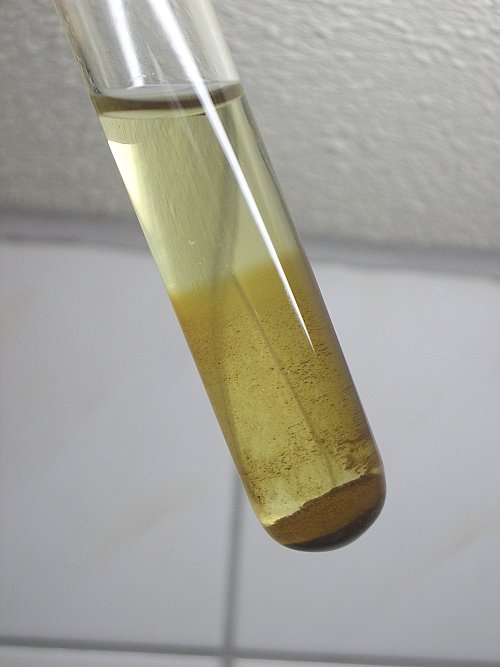
![]()
Oxidation state +5
This is a very unstable oxidation state for chromium. In
the solid state, this oxidation state can be obtained for the compound
potassium
tetraperoxochromate (V). In
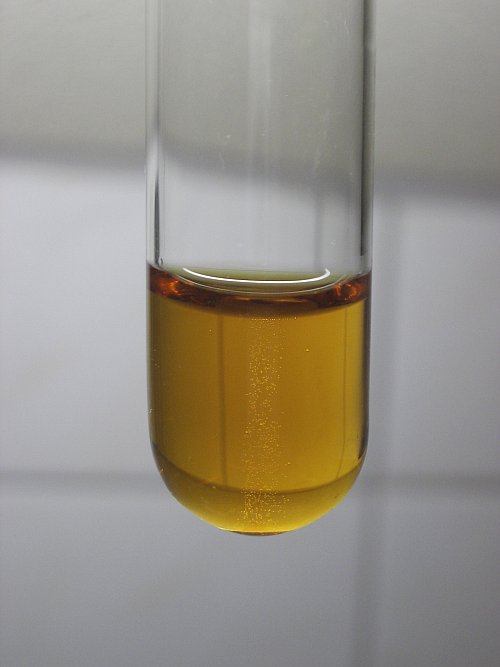 aqueous
solution, the tetraperoxochromate (V) ion is stable only in alkaline
environments. In neutral environments, it slowly decomposes, in acidic
environments it quickly decomposes.
aqueous
solution, the tetraperoxochromate (V) ion is stable only in alkaline
environments. In neutral environments, it slowly decomposes, in acidic
environments it quickly decomposes.
An aqueous solution of potassium tetraperoxochromate (V), containing Cr(O2)43- ions, is yellow/brown. At somewhat higher concentration it is brown. The picture shows a neutral solution of this compound, which contains still some solid potassium tetraperoxochromate (V). One can also clearly see the slow partial decomposition of the solid, small bubbles of oxygen are produced.
When such a brown solution is acidified with a moderately concentrated strong acid, then it quickly decomposes. The decomposition is quite fast, it just takes seconds. Below, a sequence of pictures is given, which show the quick decomposition of the tetraperoxochromate (V) ion. Immediately, after the acid is added, the liquid becomes deep blue, but within a few seconds, its color changes to pale green or pale violet, the final color being due to some chromium (III) species. The final color depends on the acid which is added and is due to different complexes of chromium (III) being formed on decomposition of the tetraperoxochromate (V). Immediately after adding the acid, the deep blue CrO5 is formed, which in turn quickly decomposes, giving oxygen and a chromium (III) species. The turbidity in the pictures below is due to formation of many small bubbles of oxygen in the liquid.
The sequence below shows the result after adding a large excess of hydrochloric acid.
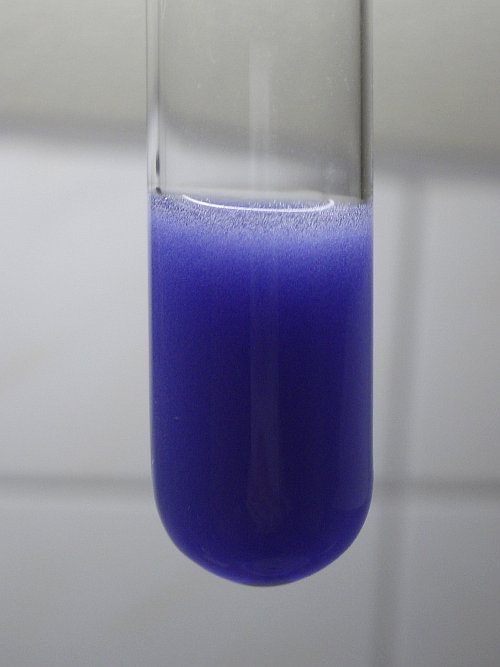
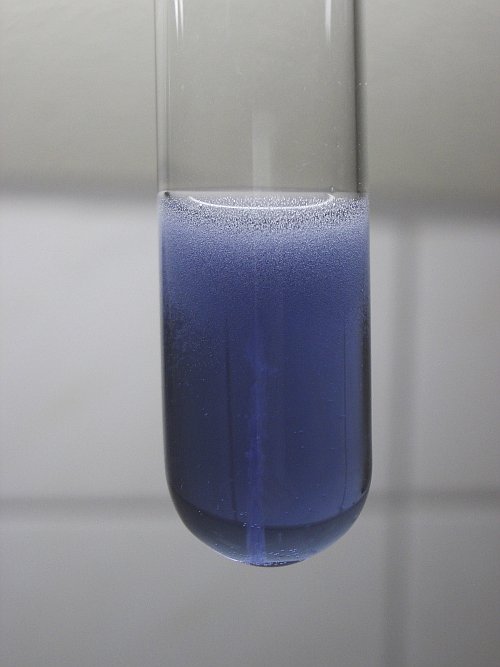
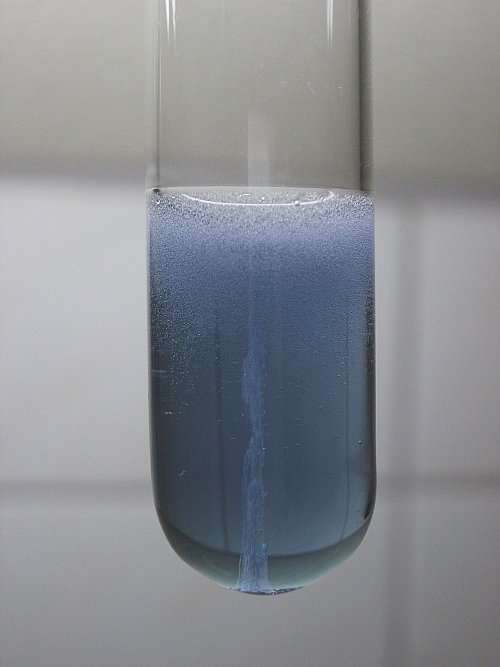

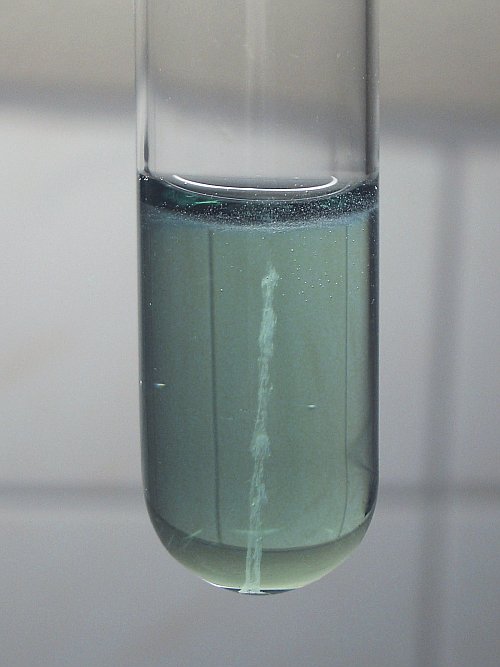
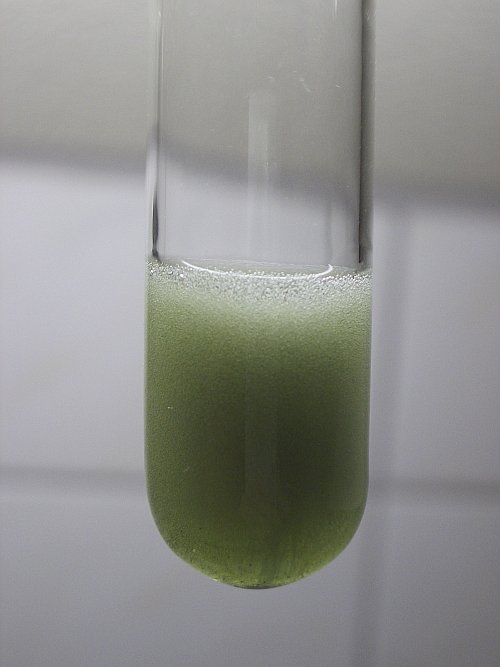 When
a very small amount of acid is added to the brown solution of
tetraperoxochromate (V), then the compound also decomposes, but the final result
is quite different. The blue transient color exists even shorter, and the final
color is of a much brighter green. The final decomposition product in this
situation contains a considerable amount of hexavalent chromium in the form of
dichromate. The mix of dichromate and chromium (III) has a brighter green/yellow
color. The picture shows the result of a similar experiment as done above, but
now only a single drop of 2% HCl being added to a dilute solution of potassium
tetraperoxochromate (V).
When
a very small amount of acid is added to the brown solution of
tetraperoxochromate (V), then the compound also decomposes, but the final result
is quite different. The blue transient color exists even shorter, and the final
color is of a much brighter green. The final decomposition product in this
situation contains a considerable amount of hexavalent chromium in the form of
dichromate. The mix of dichromate and chromium (III) has a brighter green/yellow
color. The picture shows the result of a similar experiment as done above, but
now only a single drop of 2% HCl being added to a dilute solution of potassium
tetraperoxochromate (V).
![]()
Oxidation state +6
After oxidation state +3, this is the most stable oxidation state of chromium. In acidic media, chromium in this oxidation state forms the bright orange dichromate ion Cr2O72- and in alkaline media, the bright yellow chromate ion CrO42- is formed. The dichromate ion is a fairly strong oxidizer, the chromate ion much less so.The two pictures below show a dichromate solution and a chromate solution of approximately equal concentration of chromium mass per volume.

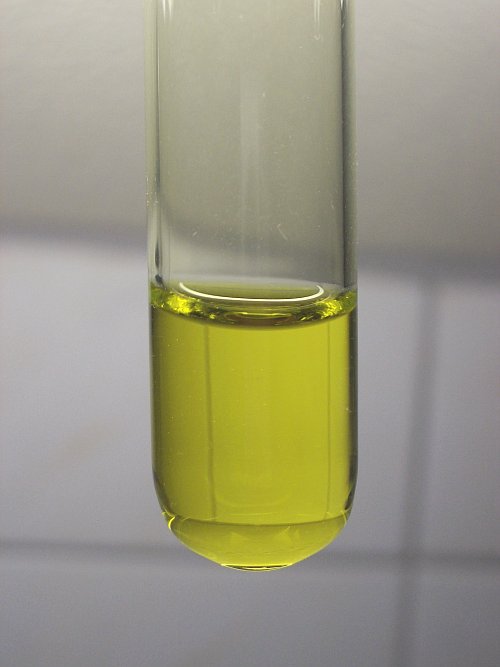
A well known and very sensitive test for either dichromate or hydrogen peroxide is the formation of the deep blue peroxide CrO5, better written as CrO(O2)2.
Below, a picture is shown of a very dilute solution, containing the blue chromium (VI) peroxide. This was prepared by taking a few drops of the orange solution, shown above, and adding a very dilute solution of H2O2 and HCl to this (less than 0.5% of each).
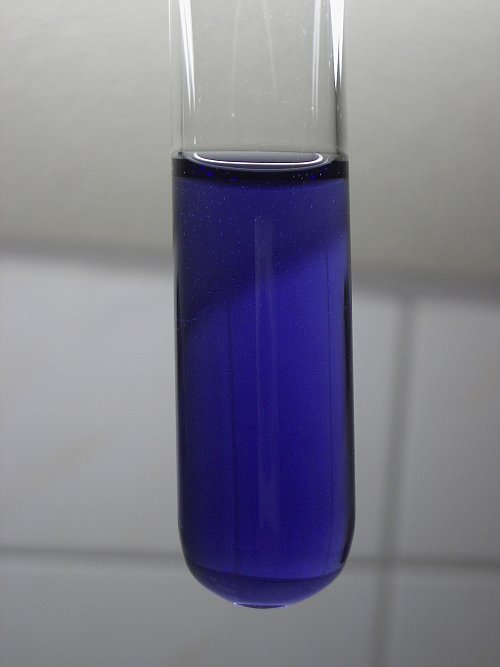
As the picture shows, the color is really deep and really intense for such a low concentration.
The blue color quickly fades. The more concentrated and the higher the temperature, the faster it fades. A sequence of pictures is given here, which shows the fading of the color. The pictures were made with an interval of 30 to 60 seconds between making two pictures.

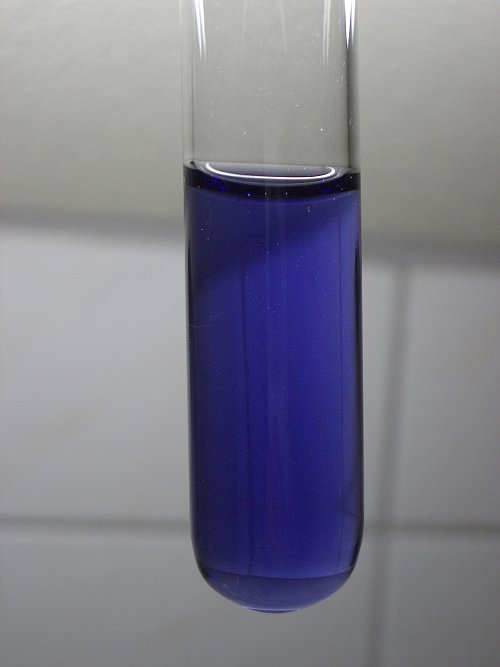
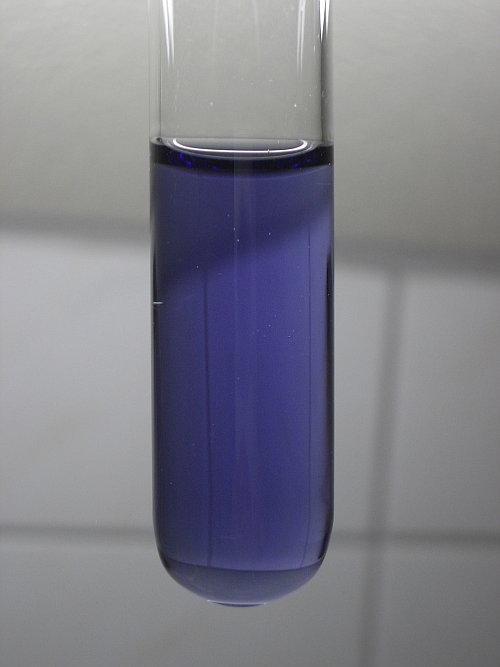
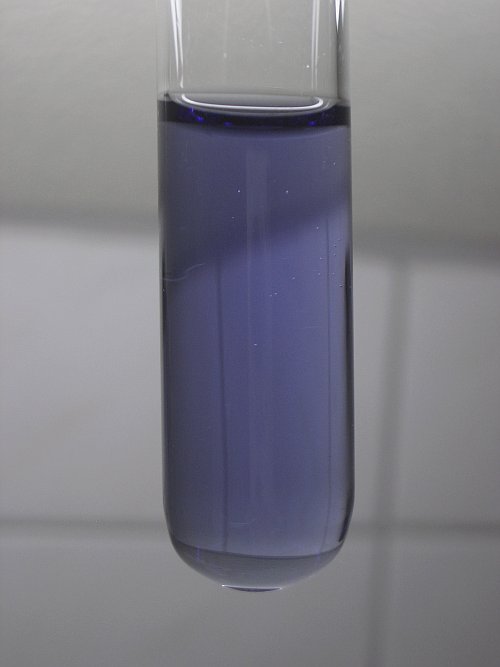
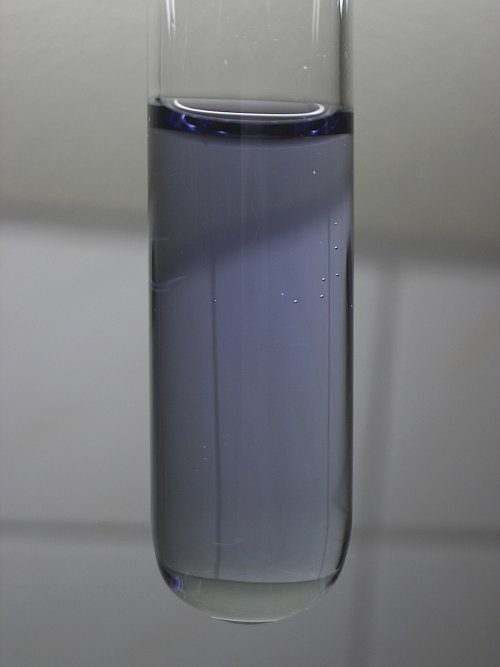
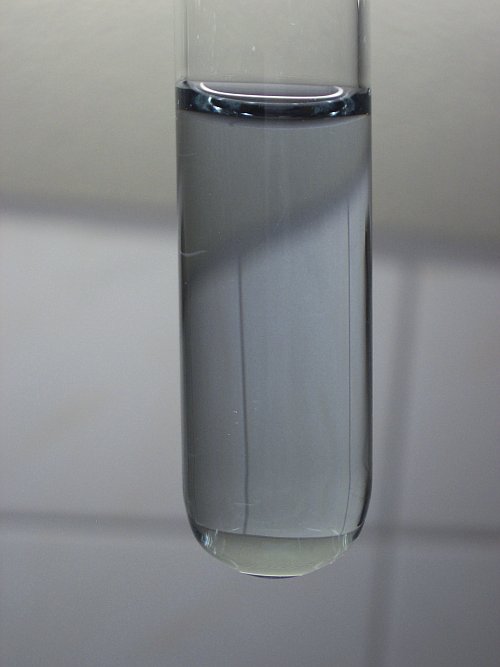
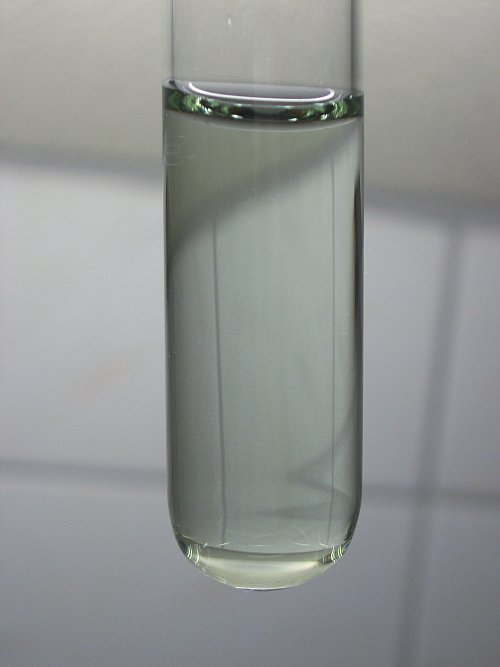
The final color is light green. The weakness of the final green color also shows, how intense the blue color is. The green color of chromium (III) already is quite intense, as is shown above in the section on chromium (III).
Chromium in its +6 oxidation state can also exist as a very volatile liquid, with an orange/brown vapor. This liquid is called chromyl chloride and it has formula CrO2Cl2. The picture below shows some vapor of chromyl chloride. The picture also shows some of the liquid, which is deep red with a purplish hue.
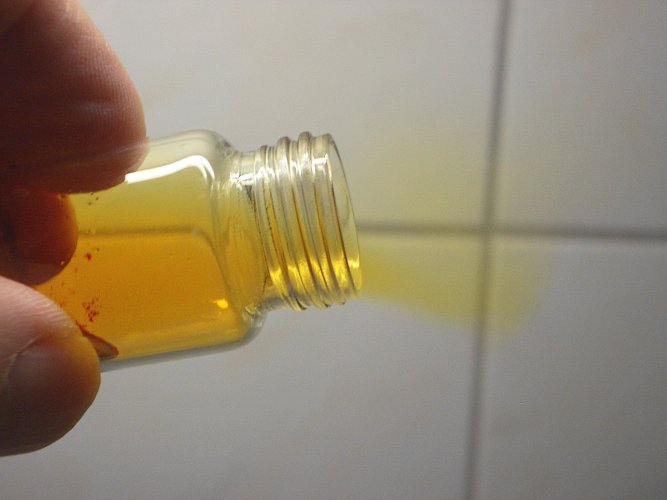
This orange/brown compound is extremely toxic and corrosive. With most organic compounds it reacts violently and some organic compounds are ignited on contact with chromyl chloride. However, it is really remarkable to have a metal-compound, being a colored gas.
back to solutions/precipitates main page
back to miscellaneous main page